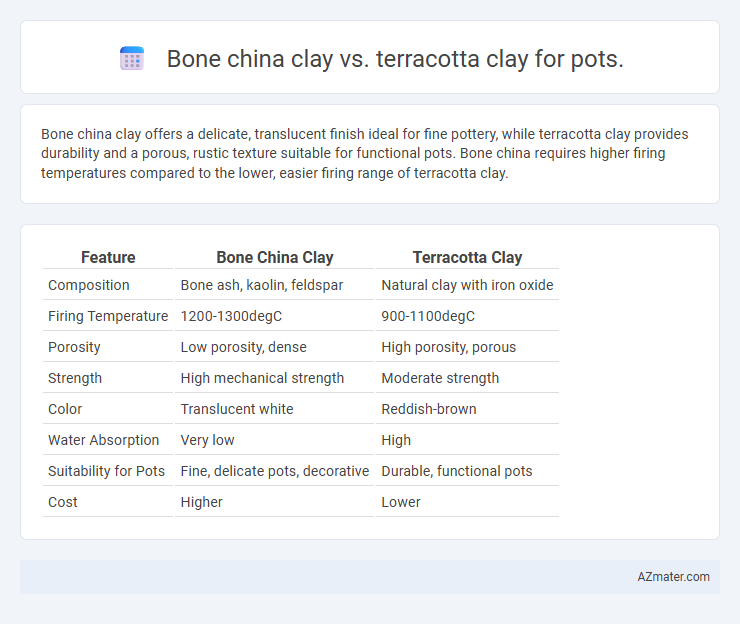Bone china clay offers a delicate, translucent finish ideal for fine pottery, while terracotta clay provides durability and a porous, rustic texture suitable for functional pots. Bone china requires higher firing temperatures compared to the lower, easier firing range of terracotta clay.
Table of Comparison
| Feature | Bone China Clay | Terracotta Clay |
|---|---|---|
| Composition | Bone ash, kaolin, feldspar | Natural clay with iron oxide |
| Firing Temperature | 1200-1300degC | 900-1100degC |
| Porosity | Low porosity, dense | High porosity, porous |
| Strength | High mechanical strength | Moderate strength |
| Color | Translucent white | Reddish-brown |
| Water Absorption | Very low | High |
| Suitability for Pots | Fine, delicate pots, decorative | Durable, functional pots |
| Cost | Higher | Lower |
Introduction to Bone China Clay and Terracotta Clay
Bone china clay is a refined ceramic material composed primarily of bone ash, kaolin, and feldspar, renowned for its high strength, translucency, and smooth, white finish ideal for fine, delicate pottery. Terracotta clay, made from natural earthen clay rich in iron oxide, is porous, coarse, and reddish-brown, commonly used for rustic, durable pots suited for outdoor gardening and traditional pottery. These distinct compositions result in bone china being favored for decorative, elegant ceramics, while terracotta excels in functional, breathable containers for plants.
Composition and Source Materials
Bone china clay contains a high percentage of refined kaolin, feldspar, and bone ash, which provides its characteristic translucency and strength, sourced primarily from animal bones. Terracotta clay consists mainly of natural red or brown iron-rich earthenware clay, with minimal processing, derived from locally available clay deposits rich in iron oxide. The differing mineral compositions and source materials significantly affect their firing temperatures, porosity, and final texture in pottery.
Physical Properties Comparison
Bone china clay exhibits a fine, smooth texture with high translucency and strength due to its high calcium phosphate content, making it denser and less porous than terracotta clay. Terracotta clay offers a coarse texture with greater porosity and lower mechanical strength, resulting in a more rustic, breathable pot ideal for plant cultivation. The firing temperature for bone china is higher, around 1200-1250degC, yielding a vitrified, non-porous surface, whereas terracotta is typically fired at 900-1100degC, producing a porous, reddish-brown finish.
Color and Aesthetic Differences
Bone china clay offers a translucent, white to off-white color with a smooth, glossy finish, enhancing the elegance of pots and making them ideal for fine decorative pieces. Terracotta clay, characterized by its natural reddish-brown or earthy tones and matte texture, imparts a rustic, warm aesthetic popular in traditional and outdoor pottery. The color vibrancy of bone china clay provides a refined, delicate look, whereas terracotta's rich, organic hues contribute to a robust, handcrafted appeal.
Durability and Strength
Bone china clay exhibits higher durability and strength compared to terracotta clay due to its refined composition and the inclusion of bone ash, which enhances its toughness and makes it less prone to chipping. Terracotta, being more porous and less fired at high temperatures, tends to be more fragile and susceptible to cracks under stress or impact. For pots requiring long-lasting strength and resistance to breakage, bone china clay is the superior material choice.
Porosity and Water Absorption
Bone china clay exhibits low porosity and minimal water absorption, making it highly durable and ideal for fine, vitrified pottery that resists moisture penetration. Terracotta clay, by contrast, is porous and absorbs more water, which can lead to increased susceptibility to damage and requires glazing to improve water resistance. The significantly lower water absorption rate in bone china enhances its use in functional items that demand impermeability compared to the more porous terracotta pots.
Firing Temperatures and Techniques
Bone china clay requires high firing temperatures around 1200-1250degC, resulting in a translucent, strong, and vitrified finish ideal for fine pottery. Terracotta clay fires at lower temperatures, typically between 900-1100degC, producing a porous and more rustic pot with a characteristic reddish-brown color. Techniques for bone china emphasize precise temperature control and slow cooling to prevent warping, while terracotta allows for more flexible firing methods often in traditional wood or gas kilns.
Suitability for Pottery and Pots
Bone china clay offers fine particle size and high plasticity, making it suitable for delicate, thin-walled pottery and pots with intricate details. Terracotta clay, known for its coarse texture and porous nature, is ideal for sturdy, rustic pots often used for plant containers due to its excellent breathability. While bone china clay produces smooth, translucent finishes, terracotta clay excels in durability and natural earthy aesthetics for functional pottery.
Environmental Impact and Sustainability
Bone china clay, derived from refined kaolin and bone ash, offers a low environmental footprint due to its high firing efficiency and durability, reducing waste over time. Terracotta clay is more abundant and natural but requires higher energy for firing and tends to be less durable, leading to more frequent replacements and environmental strain. Sustainable pottery practices favor bone china clay for longevity and energy-efficient production while acknowledging terracotta's renewable source and biodegradability.
Cost and Market Availability
Bone china clay is typically more expensive due to its refined composition and high firing temperatures, making it less accessible for casual potters. Terracotta clay, widely available and affordable, is favored in mass production and beginner ceramics due to its lower cost and ease of use. Market availability sees terracotta dominating in global pottery supply chains, while bone china remains niche, primarily within high-end tableware and decorative pottery markets.

Infographic: Bone china clay vs Terracotta clay for Pot
 azmater.com
azmater.com